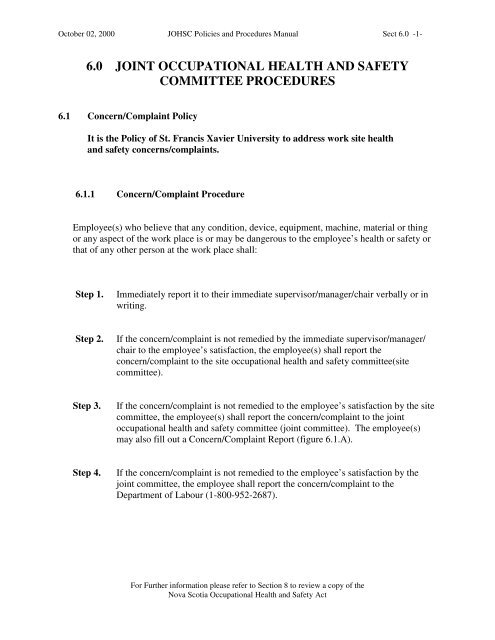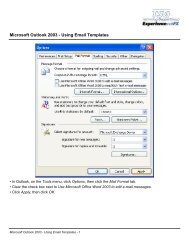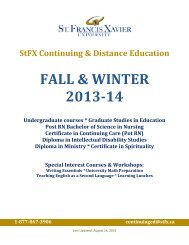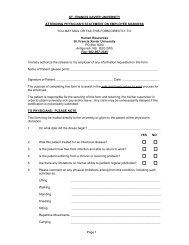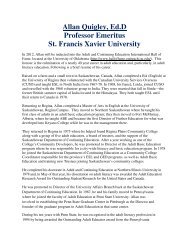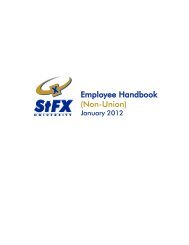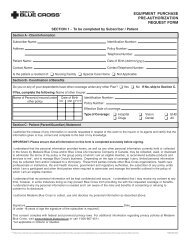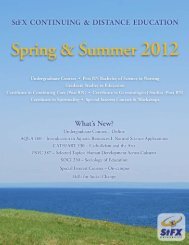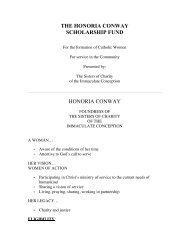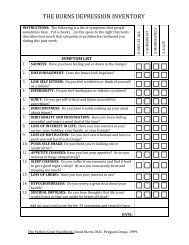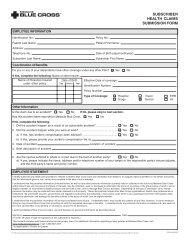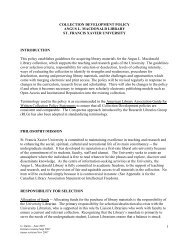6.0 joint occupational health and safety committee procedures
6.0 joint occupational health and safety committee procedures
6.0 joint occupational health and safety committee procedures
You also want an ePaper? Increase the reach of your titles
YUMPU automatically turns print PDFs into web optimized ePapers that Google loves.
October 02, 2000JOHSC Policies <strong>and</strong> Procedures ManualSect <strong>6.0</strong> -1-<strong>6.0</strong> JOINT OCCUPATIONAL HEALTH AND SAFETYCOMMITTEE PROCEDURES6.1 Concern/Complaint PolicyIt is the Policy of St. Francis Xavier University to address work site <strong>health</strong><strong>and</strong> <strong>safety</strong> concerns/complaints.6.1.1 Concern/Complaint ProcedureEmployee(s) who believe that any condition, device, equipment, machine, material or thingor any aspect of the work place is or may be dangerous to the employee’s <strong>health</strong> or <strong>safety</strong> orthat of any other person at the work place shall:Step 1.Immediately report it to their immediate supervisor/manager/chair verbally or inwriting.Step 2.If the concern/complaint is not remedied by the immediate supervisor/manager/chair to the employee’s satisfaction, the employee(s) shall report theconcern/complaint to the site <strong>occupational</strong> <strong>health</strong> <strong>and</strong> <strong>safety</strong> <strong>committee</strong>(site<strong>committee</strong>).Step 3.If the concern/complaint is not remedied to the employee’s satisfaction by the site<strong>committee</strong>, the employee(s) shall report the concern/complaint to the <strong>joint</strong><strong>occupational</strong> <strong>health</strong> <strong>and</strong> <strong>safety</strong> <strong>committee</strong> (<strong>joint</strong> <strong>committee</strong>). The employee(s)may also fill out a Concern/Complaint Report (figure 6.1.A).Step 4.If the concern/complaint is not remedied to the employee’s satisfaction by the<strong>joint</strong> <strong>committee</strong>, the employee shall report the concern/complaint to theDepartment of Labour (1-800-952-2687).For Further information please refer to Section 8 to review a copy of theNova Scotia Occupational Health <strong>and</strong> Safety Act
October 02, 2000JOHSC Policies <strong>and</strong> Procedures ManualSect <strong>6.0</strong> -2-6.1.2 Remedying a Concern/ComplaintWhere a site <strong>committee</strong> or the <strong>joint</strong> <strong>committee</strong> receives a concern/complaint from anemployee, it shall investigate <strong>and</strong> promptly dispose of the concern/complaint in accordancewith Section 31(c) of the Act.In its investigation <strong>and</strong> disposition of the concern/complaint, the site <strong>committee</strong> or <strong>joint</strong><strong>committee</strong> may involve the University <strong>occupational</strong> <strong>health</strong> <strong>and</strong> <strong>safety</strong> officer <strong>and</strong> may:interview employee(s), supplier(s) or others.examine all documents, both electronic <strong>and</strong> paper.determine which employee(s), supervisor/manager/chair or site <strong>committee</strong>representatives will be present during the <strong>joint</strong> <strong>committee</strong> investigation.designate a sub<strong>committee</strong> to further investigate into the concern/complaint.request expertise from external agencies.set a time frame to address <strong>and</strong> resolve the concern/complaint.advise the employee(s), supervisor/manager/chair or the site<strong>committee</strong>, on a resolution.submit a written recommendation to the President of the University ordesignate for approval. (Recommendation, Section 6.4 Figure 6.4.A).All Concern/Complaint Reports, information, <strong>and</strong> correspondences gathered during theresolution process shall be maintained by the University Occupational Health <strong>and</strong> Safety Officer.(Refer to Section 3.2.3 of the University’s Occupational Health <strong>and</strong> Safety Program)For Further information please refer to Section 8 to review a copy of theNova Scotia Occupational Health <strong>and</strong> Safety Act
October 02, 2000JOHSC Policies <strong>and</strong> Procedures ManualSect <strong>6.0</strong> -3-Figure 6.1. ASt. Francis Xavier UniversityJoint Occupational Health <strong>and</strong> Safety CommitteeConcern/Complaint ReportPlease Complete <strong>and</strong> forwarded to the University Occupational Health & Safety OfficerEMPLOYEE SECTIONDepartment__________________________________________ Date Submitted____________________Employee Name______________________________________ Phone___________________________Supervisor/Manager/Chair Name_________________________ Phone ___________________________Describe theconcern/complaint_________________________________________________________________________________________________________________________________________________________________________________________________________________________________________________________________________________________________________________________________________________________________________________________________________________________________________________________________________________________________________________________________________________________________________________________________________________________________________________________________________________________University Occupational Health & Safety Officer’s SectionReceived by_________________________________________ Date____________________________FOLLOW-UP_________________________________________________________________________________________________________________________________________________________________________________________________________________________________________________________________________________________________________________________________________________________________________________________________________________________________________JOINT OCCUPATIONAL HEALTH & SAFETY COMMITTEE (JOHSC)RESOLUTION____________________________________________________________________________________________________________________________________________________________________________________________________________________________________________________________________________________________________________________________________________________________________________________________________________________________________________________________________________________________________________________________________________________________________________Chair’s Signature________________________________ Date_________________________For Further information please refer to Section 8 to review a copy of theNova Scotia Occupational Health <strong>and</strong> Safety Act
October 02, 2000JOHSC Policies <strong>and</strong> Procedures ManualSect <strong>6.0</strong> -4-6.2 Work Refusal PolicyIt is the Policy of St. Francis Xavier University to address workplace <strong>health</strong><strong>and</strong> <strong>safety</strong> work refusals.6.2.1 Work Refusal ProcedureAn employee may refuse to do any act in the workplace where the employee hasreasonable grounds for believing that the act is likely to endanger the employee’s <strong>health</strong>or <strong>safety</strong> or the <strong>health</strong> or <strong>safety</strong> of any person.Step 1.Step 2.Step 3.Step 4.Step 5.Where an employee exercised the right to refuse to work pursuant to Section43(1) of the Act, the employee(s) shall immediately report their refusal <strong>and</strong> thereasons therefore to their immediate supervisor/manager/chair.The employee <strong>and</strong> the immediate supervisor/manager/chair may work together tocorrect the unsafe work situation.If the unsafe situation is resolved to the satisfaction of the employee, theemployee shall return to work.If the unsafe situation is not remedied to the employee’s satisfaction, theemployee shall report the matter to the site <strong>occupational</strong> <strong>health</strong> <strong>and</strong> <strong>safety</strong><strong>committee</strong> or the Joint Occupational Health <strong>and</strong> Safety. The employee may fillout a Work Refusal Report (Figure 6.2.A).The site <strong>committee</strong> <strong>and</strong>/or Joint Occupational Health <strong>and</strong> Safety shall notify theUniversity Occupational Health <strong>and</strong> Safety Officer <strong>and</strong> the <strong>joint</strong> <strong>committee</strong> shallcall an emergency meeting during which if may:• interview relevant employee(s), suppliers or other.• examine all relevant documentation, both electronic <strong>and</strong> paper.• determine whether or not employee(s), supervisor/manager/chair or site<strong>committee</strong> members will be present during the <strong>joint</strong> <strong>committee</strong> investigation.• designate a sub<strong>committee</strong> to address the work refusal.• submit a written recommendation to the President of the University ordesignate for approval. (Recommendation, Section 6.4 Figure 6.4.A).For Further information please refer to Section 8 to review a copy of theNova Scotia Occupational Health <strong>and</strong> Safety Act
October 02, 2000JOHSC Policies <strong>and</strong> Procedures ManualSect <strong>6.0</strong> -5-Step 6.If the Joint <strong>committee</strong> is unanimous, it may direct the employee(s) to return towork. If the <strong>joint</strong> <strong>committee</strong> is not unanimous in the decision, it shall report thematter to the Department of Labour.Step 7.If the matter is not remedied to the employee’s satisfaction by the site <strong>committee</strong>or the <strong>joint</strong> <strong>committee</strong>, the employee shall report the matter to the Dept of Labour(1-800-952-2687).Step 8.An Officer of the Department of Labour shall investigate the matter <strong>and</strong> myadvise the employee to return to work.6.2.2 Restriction On Assignment of Work Where Refusal (Section 44 of the Act)If an employee has excised his/her right to refuse to work, no other employee shallbe assigned to do that work by the University until the matter had been dealt withunder Section 43 of the Act unless the new employee to be so assigned has beenadvised of:(a)(b)(c)the refusal by another employee;the reason for the refusal; <strong>and</strong>the employee’s rights pursuant to Section 43 of the Act.6.2.3 Reassignment of Work (Section 43, 5-9 of the Act)(1) Subject to any applicable collective agreement, <strong>and</strong> Section 43, (3) of the Act, where anemployee refuses to do work pursuant to Section 43, (1) of the Act, the University mayreassign the employee to other work <strong>and</strong> the employee shall accept the reassignment untilthe employee is able to return to work pursuant to Section 43, (1) of the Act.(2) Where an employee is reassigned to other work pursuant to Section 43, (5) of the Act, theUniversity shall pay the employee the same wages or salary <strong>and</strong> grant the employee thesame benefits as would have been received had the employee continued in the employee'snormal work.For Further information please refer to Section 8 to review a copy of theNova Scotia Occupational Health <strong>and</strong> Safety Act
October 02, 2000JOHSC Policies <strong>and</strong> Procedures ManualSect <strong>6.0</strong> -6-(3) Where an employee has refused to work pursuant to Section 43, (1) of the Act <strong>and</strong> hasnot been reassigned to other work pursuant to Section 43, (5) of the Act, the Universityshall, until clause Section 43, (1)(a), (b) or (c) of the Act is met, pay the employee thesame wages or salary <strong>and</strong> grant the employee the same benefits as would have beenreceived had the employee continued to work.(4) A reassignment of work pursuant to Section 43, (5) is not discriminatory action pursuantto Section 45 of the Act.(5) An employee may not, pursuant to this Section 43 of the Act, refuse to use or operate amachine or thing or to work in a place where(a) the refusal puts the life, <strong>health</strong> or <strong>safety</strong> of another person directly indanger; or(b) the danger referred to in Section 43, (1) of the Act, is inherent in the work of theemployee.All Work Refusal Reports, information, <strong>and</strong> correspondence gather during the resolutionprocess shall be maintained by the University Occupational Health <strong>and</strong> Safety Officer.(Refer to Section 3.2.3 of the University’s Occupational Health <strong>and</strong> Safety Program).For Further information please refer to Section 8 to review a copy of theNova Scotia Occupational Health <strong>and</strong> Safety Act
October 02, 2000JOHSC Policies <strong>and</strong> Procedures ManualSect <strong>6.0</strong> -7-Figure 6.2. ASt. Francis Xavier UniversityJoint Occupational Health <strong>and</strong> Safety CommitteeWork Refusal ReportPlease Complete <strong>and</strong> forwarded to the Joint Occupational Health <strong>and</strong> Safety CommitteeEMPLOYEE SECTIONDepartment_____________________________________ Date Submitted_________________________Employee Name__________________________________Phone________________________________Supervisor/Manager/Chair Name____________________ Phone ________________________________Describe the Work Refusal _________________________________________________________________________________________________________________________________________________________________________________________________________________________________________________________________________________________________________________________________________________________________________________________________________________________________________________________________________________________________________________________________________________________________________________________________________________________________________________________________________________Joint Occupational Heath <strong>and</strong> Safety Committee (JOHSC) SectionReceived by____________________________________ Date__________________________________Time Work Refusal Received_______________ Time of Emergency Meeting______________________Attendance:1._____________________________________ 5. _____________________________________2._____________________________________ 6. _____________________________________3._____________________________________ 7. ____________________________________4._____________________________________ 8._____________________________________Copy of Minutes attached to Form __________Yes __________ NoRESOLUTION__________________________________________________________________________________________________________________________________________________________________________________________________________________________________________________________________________________________________________________________________________________________________________________________________________________________________________________________________________________________________________________________________________________________________________________________________________________________________________________________________________________________________________________________________Signatures:Chair _______________________________Employee_________________________________For Further information please refer to Section 8 to review a copy of theNova Scotia Occupational Health <strong>and</strong> Safety Act
October 02, 2000JOHSC Policies <strong>and</strong> Procedures ManualSect <strong>6.0</strong> -8-6.3 Release of Information PolicyIt is the Policy of St. Francis Xavier University to make available OccupationalHealth <strong>and</strong> Safety Information, Reports <strong>and</strong> Work Site Inspections to employees.6.3.1 Release of Information ProcedureWhen the Joint Occupational Health <strong>and</strong> Safety Committee (JOHSC) receives OccupationalHealth <strong>and</strong> Safety Information, Reports or Work Site Inspections from Consultants,Department of Labour, Other Regulatory Agencies, or any other means;The JOHSC shall request;the University Occupational Health <strong>and</strong> Safety Officer to forward copies ofthe Occupational Health <strong>and</strong> Safety information, reports or work siteinspections to:Supervisor/Manager/Chair of the department <strong>and</strong>/or building.Site Occupational Health <strong>and</strong> Safety Committees.Angus L. Macdonald Library <strong>and</strong> placed on Reserve.Please note: All Occupational Health <strong>and</strong> Safety Informationplaced on reserve in the Library is available for all employees.Employee(s) who have submitted requests in writing to the JOHSC orthe University Occupational Health <strong>and</strong> Safety Officer.Or as directed by the JOHSCOnce initial Occupational Health <strong>and</strong> Safety information, reports or work site inspectionshave been reviewed by the Joint Occupational Health <strong>and</strong> Safety Committee, the UniversityOccupational Health <strong>and</strong> Safety Officer will accept all written requests for information.(Refer to Section 3.2.3 of the University’s Occupational Health <strong>and</strong> Safety Program).For Further information please refer to Section 8 to review a copy of theNova Scotia Occupational Health <strong>and</strong> Safety Act
October 02, 2000JOHSC Policies <strong>and</strong> Procedures ManualSect <strong>6.0</strong> -9-6.3.2 Communication Requirements:Each Site Occupational Health <strong>and</strong> Safety Committee will post the following information ondedicated Occupational Health <strong>and</strong> Safety bulletin boards on campus:Occupational Health <strong>and</strong> Safety Information to be posted on AllOccupational Health <strong>and</strong> Safety Bulletin BoardsThe Nova Scotia Occupational Health <strong>and</strong> Safety ActAll Acts, Regulations, <strong>and</strong> Codes of Practice that are relevant to theDepartment or Work Sites.The University’s Occupational Health <strong>and</strong> Safety Policy.The 24 hour telephone number for the Department of Labour:(8)1-800-9LABOUR, (8)1-800-952-2687Site Occupational Health <strong>and</strong> Safety Committee information including: names of Health <strong>and</strong> Safety Committee Members their work locations telephone numbers on campus.Names of Employees who are qualified in Emergency/St<strong>and</strong>ard FirstAid their work locations telephone numbers on campus.The most recent Site Occupational Health <strong>and</strong> Safety CommitteeSafety minutes.The most recent Joint Occupational Health <strong>and</strong> Safety Committee(JOHSC) MinutesList of current Occupational Health <strong>and</strong> Safety Reports, Information,Tests <strong>and</strong> Workplace Inspections for this location <strong>and</strong> how to accessthis information.Department of Labour Inspection <strong>and</strong>/or Orders.Any other information as directed by the Joint Occupational Health <strong>and</strong>Safety Committee or as required by legislation.Emergency Preparedness Information Location: St Francis Xavier University Building name: Phone # Room # Fire/RCMP/Ambulance:(8) 911 or 911 Poison Control : (8)1-800-565-8161 Environmental Emergencies: (8)1-800-565-1633 Security: 3981Fire Evacuation /Emergency Plan for this locationAny other Emergency telephone numbers or Information relevantto the department.For Further information please refer to Section 8 to review a copy of theNova Scotia Occupational Health <strong>and</strong> Safety Act
October 02, 2000JOHSC Policies <strong>and</strong> Procedures ManualSect <strong>6.0</strong> -10-6.4 Recommendation PolicyIt is the Policy of St. Francis Xavier University to address OccupationalHealth <strong>and</strong> Safety Recommendations. Using the following steps the purposeof a Recommendation is to reduce or eliminate the <strong>health</strong> <strong>and</strong> <strong>safety</strong> issue byconsidering:EliminationSubstitutionEngineering ControlsAdministrative Controls6.4.1 Recommendation Procedure:When the Joint Occupational Health <strong>and</strong> Safety Committee (JOHSC) becomes aware of anOccupational Health <strong>and</strong> Safety issue from; Concern/Complaint Report Record Keeping Hazardous Assessment Safety Meeting (tool box) Minutes Incident/Accident Investigation Training Workplace Inspections Incident Reports Written Job Procedures Any other means Safe Work Practices Site Occupational Health <strong>and</strong> Safety Committees RecommendationsThe JOHSC may wish to review all Occupational Health <strong>and</strong> Safety report(s) relevant tothe <strong>safety</strong> issue prior to submitting a written recommendation.Step 1.Step 2.The Joint Occupational Health <strong>and</strong> Safety Committee (JOHSC) mayconduct a hazard assessment. Please refer to Section 6.5.2 Hazard Assessment.The Joint Occupational Health <strong>and</strong> Safety Committee (JOHSC) willthen proceed by submitting in writing a Recommendation to the President of theUniversity or Designate for approval. (Figure 6.4.A).Step 3.The JOHSC will schedule a meeting within 21days post the submission of aRecommendation Report to review the response from the President of theUniversity or Designate.For Further information please refer to Section 8 to review a copy of theNova Scotia Occupational Health <strong>and</strong> Safety Act
October 02, 2000JOHSC Policies <strong>and</strong> Procedures ManualSect <strong>6.0</strong> -11-Step 4.Where the JOHSC receives a written response from the President of theUniversity pursuant to Section 34(1) of the Act, the JOHSC may:request clarification <strong>and</strong>/or specify conditions prior to accepting the response;if the JOHSC is in disagreement with the decision <strong>and</strong>/or the explanationprovided for the delay in responding, the Chair of the JOHSC shall report thisfact to the Department of Labour.Step 5.The JOHSC shall request the University Occupational Health <strong>and</strong> Safety Officerto forward copies of all correspondences <strong>and</strong> the Recommendation Report to theSupervisor/Manager/Chair of the department <strong>and</strong>/or building, <strong>and</strong> the SiteOccupational Health <strong>and</strong> Safety Committee.The Department of Labour’s Occupational Health <strong>and</strong> Safety Officer may investigatethe disagreement as per section 34 of the Act.The University Occupational Health <strong>and</strong> Safety Officer shall maintain all RecommendationReports, information, <strong>and</strong> correspondence gather during the resolution process. (Refer toSection 3.2.3 of the University’s Occupational Health <strong>and</strong> Safety Program).For Further information please refer to Section 8 to review a copy of theNova Scotia Occupational Health <strong>and</strong> Safety Act
October 02, 2000JOHSC Policies <strong>and</strong> Procedures ManualSect <strong>6.0</strong> -12-Figure 6.4.ASt. Francis Xavier UniversityJoint Occupational Health <strong>and</strong> Safety CommitteeRecommendation ReportTo be completed by the JOHSC CommitteeRecommendation #__________________ Date Submitted:___________________________Submitted to: _______________________ Response required within 21days_____________Supervisor/Manager/Chair Name:________________________ Department_____________RECOMMENDATION:________________________________________________________________________________________________________________________________________________________________________________________________________________________________________________________________________________________________________________________________________________________________________________________________________________________________________________________________________________________________________________________________________________________________________________________________________________________________________________BACKGROUND INFORMATION:______________________________________________________________________________________________________________________________________________________________________________________________________________________________________________________________________________________________________________________________________________________________________________________________________________________________________________________________________________________________________________________________________________________________________________________________________________________________________________________________________________________________________________________________________________________________________________________________________________________________________________________________________________________________________________________________________________________________________________________________________________________________________________________________________________________________________________________________________________________________________________________________________________________________________________________________________________________________________________________________________________________________________________Chair’s signature________________________________________ Date __________________________For Further information please refer to Section 8 to review a copy of theNova Scotia Occupational Health <strong>and</strong> Safety Act
October 02, 2000JOHSC Policies <strong>and</strong> Procedures ManualSect <strong>6.0</strong> -13-6.5 Hazard Identification PolicyIt is the Policy of St. Francis Xavier University to continuously strive toidentify <strong>health</strong> <strong>and</strong> <strong>safety</strong> work site hazards. The JOHSC shall promoteawareness of <strong>health</strong> <strong>and</strong> <strong>safety</strong> work site hazards by defining a hazard as: anythingthat has the potential to cause injury, illness or disease.6.5.1 Hazard Identification ProcedureEmployees are asked to use the following table as a guide in evaluating the design <strong>and</strong> layoutof the work site as well as the work process, equipment, substances <strong>and</strong> machines used toperform job related responsibilities to determine if hazards exist.Hazard Identification Table YES NO1. Chemical hazards such as a chemical or material used in theworkplace, or a process, or material by-product.2. Physical hazards such as noise, vibration, heat stress, cold stress,or radiation.3. Ergonomic hazards such as work which requires awkwardposture, repetitious motion, or excessive muscular force.4. Hazards specific to machinery, materials, tools <strong>and</strong> equipment inuse.5. Hazards related to particular work processes <strong>and</strong> workenvironments.6. Biological hazards including viruses, bacteria, fungi, orparasites.7. Hazards from energy sources such as electrical, compressed airor gases, hydraulic, gravity, chemical or heat.8. Is there a risk of slipping, tripping, or falling?9. Can any part of the body be caught in or between objects, or atrisk of objects falling?10. Hazards created through nonexistent or inadequate workpractices or taking shortcuts.11. Hazards created when proper work practices are not followed.12. Are there known factors affecting Indoor Air Quality?13. Are Fire Exits clearly marked, egress/access routes unobstructed,fire fighting equipment serviceable <strong>and</strong> inspected routinely?14. Are first aid supplies maintained <strong>and</strong> inspected routinely <strong>and</strong> arethere trained personnel available.15. Are there unforeseen factors that may affect work related duties<strong>and</strong> work sites.(i.e. deadlines, time of day, time of year, crowds,traffic, weather, etc.)16. Other factors as outlined by the departmentFor Further information please refer to Section 8 to review a copy of theNova Scotia Occupational Health <strong>and</strong> Safety Act
October 02, 2000JOHSC Policies <strong>and</strong> Procedures ManualSect <strong>6.0</strong> -14-6.5.2 Hazard AssessmentIn conducting a hazard assessment, employees <strong>and</strong> their supervisor/manager/chair shallstudy the design <strong>and</strong> layout of the work site as well as the work process, equipment,substances <strong>and</strong> machines used to perform job related responsibilities to determine if hazardsexist. When a work related hazard has been identified (refer to section 6.5.1), it must beproperly examined to identify all risks associated with it. The following steps offer a guideon how to manage the risks associated with the hazard.Step 1.Elimination.Can the hazard be successfully removed without restricting the design <strong>and</strong> layoutof the work site as well as the work process, equipment, substances <strong>and</strong> machinesused to perform job-related responsibilities. If no, further steps are necessary tocontrol the hazard.Step 2.Substitution.The employees <strong>and</strong> supervisor/manager/chair shall consider less hazardousalternatives to the work process, equipment, substances <strong>and</strong> machines used toperform job-related responsibilities. Can any of these be replaced with a lesshazardous substitute?Step 3.Engineering Controls.The employee <strong>and</strong> supervisor/manager/chair may wish to examine engineeringcontrols that relate to the design <strong>and</strong> layout of the work site as well as the workprocess, equipment, substances <strong>and</strong> machines used to perform job relatedresponsibilities. Common engineering controls involve mechanical, electrical,structural <strong>and</strong> ergonomics.Step 4.Administrative Controls.Finally, if the hazard cannot be reduced to an acceptable level of risk by usingsubstitution or engineering controls, administrative support will be necessary.Administrative support includes but not limited to; Introducing new policies Changing work processes Providing proper personal protective equipment Implementing written safe work practices <strong>and</strong> <strong>procedures</strong> As deemed necessary to reduce the hazard to an acceptable level of risk.For Further information please refer to Section 8 to review a copy of theNova Scotia Occupational Health <strong>and</strong> Safety Act
October 02, 2000JOHSC Policies <strong>and</strong> Procedures ManualSect <strong>6.0</strong> -15-6.5.3 Written Safe Work ProceduresWritten safe work <strong>procedures</strong> are step b y step instructions on how to perform job- relatedresponsibilities once potential hazards have been identified either with the design or layoutof the work site, with the work process, equipment, substances or machines used to performthe job, task, or procedure.Potential hazards are rated (refer to section 6.8.1) by the supervisor/manager/chair based onthe following scale;• #1 Major• # 2 Serious• # 3 Minor• # 4 Non-hazardous.Potential hazards that are rated;• # 1 Major, shall have safe written work <strong>procedures</strong> at the work site.• # 2 Serious, may have safe written work <strong>procedures</strong> at the work site as determined bythe supervisor/manager/chair <strong>and</strong> the site <strong>occupational</strong> <strong>health</strong> <strong>and</strong> <strong>safety</strong> <strong>committee</strong>.• # 3 Minor, may have safe written work <strong>procedures</strong> at the work site as determined by thesupervisor/manager/chair <strong>and</strong> the site <strong>occupational</strong> <strong>health</strong> <strong>and</strong> <strong>safety</strong> <strong>committee</strong>.• # 4 Non-hazardous, may have safe written work <strong>procedures</strong> at the work site asdetermined by the supervisor/manager/chair <strong>and</strong> the site <strong>occupational</strong> <strong>health</strong> <strong>and</strong> <strong>safety</strong><strong>committee</strong>.There are four main goals to consider prior to writing safe work <strong>procedures</strong>.The first goal is to properly identify potential hazards. Always treat the cause not thesymptoms. (Refer to section 6.5.1)The second goal is to ensure that the most effective steps are taken to manage the risksassociated with the potential hazard. (Refer to section 6.5.2)The third goal is once the potential hazard is identified <strong>and</strong> the steps taken to managethe risks associated with the hazard, no new potential hazards have been created.The fourth goal is to write safe work <strong>procedures</strong> that will protect the <strong>health</strong> <strong>and</strong> <strong>safety</strong> ofthe employee while performing the job related responsibility.The following is a framework in which written safe work <strong>procedures</strong> shall follow.I. Safe work <strong>procedures</strong> shall be written either collectively or by individuals who arefamiliar with the design <strong>and</strong> layout of the work site as well as the work process,equipment, substances <strong>and</strong> machines used to perform job related responsibilities.For Further information please refer to Section 8 to review a copy of theNova Scotia Occupational Health <strong>and</strong> Safety Act
October 02, 2000JOHSC Policies <strong>and</strong> Procedures ManualSect <strong>6.0</strong> -16-II.III.IV.Each written safe work procedure will be specific to the design <strong>and</strong> layout of thework site as well as the work process, equipment/substances/machines, personalprotective equipment, <strong>and</strong> any potential hazards or precautions noted in performingthe job related responsibility.Employees <strong>and</strong> their supervisor/manager/chair shall review all written safe work<strong>procedures</strong> for accuracy prior to being sent forwarded to the site <strong>occupational</strong> <strong>health</strong><strong>and</strong> <strong>safety</strong> <strong>committee</strong>.All written safe work <strong>procedures</strong> shall be reviewed <strong>and</strong> adopted by the site<strong>occupational</strong> <strong>health</strong> <strong>and</strong> <strong>safety</strong> <strong>committee</strong>s prior to implementation.V. Once a written safe work procedure is implemented, the supervisor/manager/chair ofeach department is responsible to ensure that all employees who perform thejob/task/procedure is properly qualified <strong>and</strong> trained to carry out the work <strong>procedures</strong>afely.VI.VII.Once an employee is fully trained to perform a safe work procedure, thesupervisor/manager/chair of each department shall maintain a written record of theemployee’s training.Each written safe work procedure will be reviewed by the employees <strong>and</strong> thesupervisor/manager/chair of each department at least once a year or as necessary.This is to accommodate changes in the design <strong>and</strong> layout of the work site as well asthe work process, equipment/substances/machines, personal protective equipment,<strong>and</strong> any potential hazards or precautions noted in performing the job relatedresponsibility.VIII. Written safe work <strong>procedures</strong> are to be centrally located <strong>and</strong> easily reached so allemployees within the department have access to this information.IX.New employees including summer students <strong>and</strong> part-time employees shall receive ongoingtraining in all written safe work <strong>procedures</strong> that are specific to their job relatedresponsibilities.X. Safe work <strong>procedures</strong> shall be numbered according to (Refer to Figure 6.5.3.A); Department Room/lab/classroom/work site Job/task/procedure Equipment/substance/machineXI.Revisions to safe work <strong>procedures</strong> shall be numbered sequentially. With each newrevision to the safe work procedure, the existing copy is update <strong>and</strong> replaced. (Referto Figure 6.5.3.A.)For Further information please refer to Section 8 to review a copy of theNova Scotia Occupational Health <strong>and</strong> Safety Act
October 02, 2000JOHSC Policies <strong>and</strong> Procedures ManualSect <strong>6.0</strong> -17-Figure 6.5.3.ASt. Francis Xavier UniversityWritten Safe Work Procedures FormDepartment: Room/lab/classroom/work site: Job/task/procedure:Equipment/substance/machine: Safe work procedure written by: Date of Initial safe workprocedure:Safe work procedure reviewed by: Date approved: Review date:Revision number: Date of Revision: Revision approved by:Equipment, Tools, Materials Required:_____________________________________________________________________________________________________________________________________________________________________________________________________________________________________________________________________________________________________Personal Protective Equipment Required:___________________________________________________________________________________________________________________________________________________________________________________________________________________________________________________________________________________________________Procedure: (Step by Step instructions on how to complete this job/task/procedure safely)1. _______________________________________________________________________________2. _______________________________________________________________________________3. _______________________________________________________________________________4. _______________________________________________________________________________5. _______________________________________________________________________________Note any additional potential hazards as a result of the job process.6. _______________________________________________________________________________7. _______________________________________________________________________________8. ____________________________________________________________________________For Further information please refer to Section 8 to review a copy of theNova Scotia Occupational Health <strong>and</strong> Safety Act
October 02, 2000JOHSC Policies <strong>and</strong> Procedures ManualSect <strong>6.0</strong> -18-6.6 Indoor Air Quality PolicyIt is the Policy of St. Francis Xavier University to monitor <strong>and</strong> maintain acceptableIndoor Air Quality on Campus. As an employer, the University recognizes thatIndoor Air Quality is a complex issue that involves many factors consisting of;the design <strong>and</strong> layout of the work sitethe outdoor climatethe building’s heating, ventilation, <strong>and</strong> air conditions (HVAC) system if presentother sources of irritants both indoor <strong>and</strong> outdooremployees6.6.1 Assessing Indoor Air Quality ConcernsIn order to help identify <strong>and</strong> manage factors that may be affecting Indoor Air Quality, thefollowing guidelines are provided.I. Employee(s) who are experiencing Indoor Air Quality concerns are to refer toConcern/Complaint Procedure Section 6.1.1.II. At the same time, an employee(s) or the department can contact Physical Plant at 867-2149to report their concerns.Once the initial concern/complaint process has begun, the supervisor/manager/chairshall appoint an employee within the department as the key contact person tocoordinate a basic assessment to gather background information.III.The basic assessment shall consist of but not limited to;a) The number of employees experiencing Indoor Air Quality concerns.b) Employees’ location.c) The types of concern (i.e. odors, dryness, heat, cold etc.)d) Time, date <strong>and</strong> circumstances surrounding the concerns.e) Activities/events in <strong>and</strong> around the department/building.f) Employee’s physical symptoms experienced at that time.g) The number <strong>and</strong> location of employees not experiencing Indoor Air Quality concerns.h) Other factors as determined by the department <strong>and</strong>/or site <strong>occupational</strong> <strong>health</strong> <strong>and</strong><strong>safety</strong> <strong>committee</strong>.For Further information please refer to Section 8 to review a copy of theNova Scotia Occupational Health <strong>and</strong> Safety Act
October 02, 2000JOHSC Policies <strong>and</strong> Procedures ManualSect <strong>6.0</strong> -19-IV.Once a basic assessment has been completed, the employees, supervisor/manager/chair ofthe department <strong>and</strong>/or site <strong>occupational</strong> <strong>health</strong> <strong>and</strong> <strong>safety</strong> <strong>committee</strong> shall review theinformation to try <strong>and</strong> identify patterns, trends or behaviors that may be affecting IndoorAir Quality.If the employees, supervisor/manager/chair of the department <strong>and</strong>/or site <strong>occupational</strong><strong>health</strong> <strong>and</strong> <strong>safety</strong> <strong>committee</strong> can identify patterns, trends or behaviors that may beaffecting indoor air quality; Please refer to Hazard Assessment Section 6.5.2.V. If the employees, supervisor/manager/chair of the department <strong>and</strong>/or site <strong>occupational</strong><strong>health</strong> <strong>and</strong> <strong>safety</strong> <strong>committee</strong> can not identify patterns, trends or behaviors;the supervisor/manager/chair shall appoint an employee within the department as thekey contact person to coordinate the ongoing documentation either daily, weekly,monthly from fellow employees regarding their Indoor Air Quality concerns.The ongoing documentation process shall consist of but not limited to;a) What are the complaints <strong>and</strong> associated symptoms experienced?b) When do they occur (season, time, day, <strong>and</strong> frequency)?c) How long do symptoms last?d) Do they clear up after leaving work (how soon)?e) Have the symptoms been triggered by any specific activity/event in or around thedepartment or building?f) Have the symptoms been triggered in any specific area within the department orbuilding?g) Other factors as determined by the department <strong>and</strong>/or site <strong>occupational</strong> <strong>health</strong> <strong>and</strong><strong>safety</strong> <strong>committee</strong>.VI.Once the ongoing documentation process is in place the employees, supervisor/manager/chair of the department <strong>and</strong>/or site <strong>occupational</strong> <strong>health</strong> <strong>and</strong> <strong>safety</strong> <strong>committee</strong> shall reviewthe documentation on a regular basis to try <strong>and</strong> identify patterns, trends or behaviors thatmay be affecting Indoor Air Quality.If the employees, supervisor/manager/chair of the department <strong>and</strong>/or site <strong>occupational</strong><strong>health</strong> <strong>and</strong> <strong>safety</strong> <strong>committee</strong> can identify patterns, trends or behaviors that may beaffecting indoor air quality. Please refer to Hazard Assessment Section 6.5.2.If the employees, supervisor/manager/chair of the department <strong>and</strong>/or site <strong>occupational</strong><strong>health</strong> <strong>and</strong> <strong>safety</strong> <strong>committee</strong> can not identify patterns, trends or behaviors that maybe affecting indoor air quality continue with Concern/Complaint procedure Section6.1.1 Step 3.For Further information please refer to Section 8 to review a copy of theNova Scotia Occupational Health <strong>and</strong> Safety Act
October 02, 2000JOHSC Policies <strong>and</strong> Procedures ManualSect <strong>6.0</strong> -20-6.7 Accident Investigation PolicyIt is the Policy of St. Francis Xavier University to investigate all reported workplaceaccidents. Investigating workplace accidents provides insights into immediate <strong>and</strong>/orunderlying causes of accidents <strong>and</strong> prevents similar accidents in future.6.7.1 Major <strong>and</strong> Serious Accident Investigation ProcedureStep 1.Accidents are to be reported immediately to the employee’s immediatesupervisor/manager/chair.If the nature <strong>and</strong> type of accidents requires Emergency 911 services thesupervisor/manager/chair or a designated employee calls for help <strong>and</strong> reports backthat Emergency Services has been notified.Step 2.The supervisor/manager/chair shall at an accident scene;take chargesee that the area is safe by stopping any ongoing hazardsCall for help (911) if not already done soensure that they <strong>and</strong>/or other employees are not at risk while at the accident sceneensure no further damage to property occursprovide personal protective equipment if requiredassist the injured person or persons if possiblesees that first aid is administered by a trained employee or other qualified personprovide emergency resource (lighting, power, crowd control, etc)identify <strong>and</strong> preserve sources of evidence at the accident sceneidentify eye witness(es) that can contribute to the investigation.Step 3.Once the injured employee(s) has received first aid <strong>and</strong>/or has been evacuated ifnecessary, <strong>and</strong> the accident scene has been secured, the supervisor/manager/chair shallbegin the accident investigation process by observing <strong>and</strong> making written notes on thefollowing;the layout of the accident sitethe position(s) of injured worker(s)the equipment <strong>and</strong>/or tools being usedmaterial(s) being used<strong>safety</strong> devices in useFor Further information please refer to Section 8 to review a copy of theNova Scotia Occupational Health <strong>and</strong> Safety Act
October 02, 2000JOHSC Policies <strong>and</strong> Procedures ManualSect <strong>6.0</strong> -21-position of material/equipmentdamage to equipment/materialhousekeeping of areapersonal protective equipment if wornweather conditionslighting levels, time of daypersonal evidence regarding the injured employee(s) i.e. proper clothing, footwear.verify witnesses by recording names <strong>and</strong> telephone numbersother facts as deemed necessary by the supervisor/manager/chair.The supervisor/manager/chair shall take photographs, sketches <strong>and</strong> measurements of the accident sceneto assist with the investigation before anything is moved.A basic Accident Investigation Kit shall contain but not be limited to: Polaroid Camera (extra film) Measuring tape (16ft) Clip board Note pad Graph paper Pens/pencils # 2 First Aid kit 6 volt lantern style flashlight; h<strong>and</strong> held flashlight (extra batteries) Flagging tape Extra disposable gloves As deemed by departments e.g. spill kits, extra personnel protectiveequipment (PPE), sample bags.Please note: An Accident Investigation Kit is available at the office of the UniversityOccupational Health <strong>and</strong> Safety Officer 544A MacKinnon Hall.Step 4.The supervisor/manager/chair shall fill out Accident Investigative Report (Figure 6.7.A).<strong>and</strong> forward a copy to the University Occupational Health <strong>and</strong> Safety Officer by monthend.If the accident results in a serious injury. results in a fire or an explosion. results in a death.The supervisor/manager/chair shall notify the University Occupational Health <strong>and</strong> SafetyOfficer as soon as possible. The University Occupational Health <strong>and</strong> Safety Officer willthen become a member of the investigating team.For Further information please refer to Section 8 to review a copy of theNova Scotia Occupational Health <strong>and</strong> Safety Act
October 02, 2000JOHSC Policies <strong>and</strong> Procedures ManualSect <strong>6.0</strong> -22-Step 5.The University shall send written notice to the Director (Section 63, 1,2 &3 of the Act)(a) of a fire or accident at the workplace that occasions bodily injury to an employee,within seven days of its occurrence;(b) of an accidental explosion at the workplace, whether any person is injured or not,within twenty-four hours of its occurrence; <strong>and</strong>(c) where at the workplace a person is killed from any cause or is injured from any causein a manner likely to prove fatal, within twenty-four hours of the occurrence of thedeath or injury.(2) A true copy of the notice of accident required to be given by the University to theWorkers Compensation Board, pursuant to the Workers Compensation Act, may bedelivered or mailed to the Director as sufficient notice pursuant to this Section.(3) Where a notice is required to be sent to the Director pursuant to this Section, theUniversity shall furnish the <strong>committee</strong> or representative at the workplace, if any, witha copy of the notice.Step 6.Once all the evidence has been carefully collected <strong>and</strong> documented, thesupervisor/manager/chair <strong>and</strong>/or members of the Investigating Team shall begin theinterviewing process of the injured employee(s) <strong>and</strong>/or eye witness(s) as soon as possible.The purpose in conducting interviews is to gather detailed information as to whathappened.Step 7.The supervisor/manager/chair <strong>and</strong>/or members of the Investigating Team shall reviewAccident Investigation Guidelines Section 6.7.2 <strong>and</strong> all relevant documentation prior todetermining a cause(s) of the accident <strong>and</strong> WHY it happened.Step 8.The supervisor/manager/chair <strong>and</strong>/or members of the Investigating Team shall submit anAction Report (Figure 6.7.B) <strong>and</strong>/or Recommendations (Section 6.4, Figure 6.4.A) toeither the site Occupational Health <strong>and</strong> Safety Committee <strong>and</strong>/or the Joint OccupationalHealth <strong>and</strong> Safety Committee to resolve immediate <strong>and</strong>/or underlying causes of theaccident identified during the Accident Investigating process.All copies of Accident Investigation Reports, information, <strong>and</strong> correspondencesgathered during the investigation process related to Major <strong>and</strong> Serious accidents shall be maintainedby the University Occupational Health <strong>and</strong> Safety Officer. (Refer to Section 3.2.3 of theUniversity’s Occupational Health <strong>and</strong> Safety Program)For Further information please refer to Section 8 to review a copy of theNova Scotia Occupational Health <strong>and</strong> Safety Act
October 02, 2000JOHSC Policies <strong>and</strong> Procedures ManualSect <strong>6.0</strong> -23-6.7. 2 Accident Investigation GuidelinesThe following questions provide a framework in which supervisors/managers/chairs <strong>and</strong>/ormembers of the Investigating Team shall use to investigate work place accidents. By examiningall six (6) categories; Job/Task, Material, Equipment, Environment, Personal, <strong>and</strong>Management/Organization, that immediate <strong>and</strong>/or underlying causes of workplace accidentsmay be identified <strong>and</strong> corrective action(s) put in place to prevent similar accidentsin future.I. Review categories 1-6.II. By answering No to any of the questions, an Action Report (Figure 6.7.B) <strong>and</strong>/orRecommendations Report (Figure 6.4.A) may be required to resolve immediate <strong>and</strong>/orunderlying causes of workplace accidents.Category 1: Job/Task Yes No1. Was this the first time the job/task was performed?2. Was the correct safe work procedure used?3. Was there a safe work procedure written for this job/task?4. Was the safe work procedure current <strong>and</strong> up to date?5. Was there adequate supervision?6. Were all hazards identified?7. Were unsafe conditions corrected?8. Were there any unusual circumstances regarding the task/job?9. Were there previous accident reports in doing the job/task?10. Did the job/task of other employee(s) contribute to the accident?11. Was the correct tool(s) used?12. Were the correct tool(s) available?13. Was the employee(s) trained in the safe work <strong>procedures</strong>?14. Was the employee(s) trained in the use <strong>and</strong> h<strong>and</strong>ling of the correct tools for the job?15. Was the employee’s(s) training current <strong>and</strong> up to date?16. Was the job/task authorized?17. Was Personal Protective Equipment available?18. Was the employee(s) trained to use the proper Personal Protective Equipment?19. Was the condition of the Personal Protective Equipment clean <strong>and</strong> in working order?20. Was the Personal Protective Equipment suitable for the job/task?21. Were general housekeeping duties a contributing factor?22. Other questions– please specify:Category 2: MaterialYES NO1. Were there hazardous materials used?2. Was the hazardous material properly labeled?3. If a hazardous chemical, was the MSDS up to date?4. Was the MSDS accessible <strong>and</strong> did the employee know how to access this information?5. Did the employee(s) have up to date WHMIS training?6. Was the hazardous material/chemical properly stored?7. Were there proper spill <strong>procedures</strong> in place?8. Were there proper disposal <strong>procedures</strong> in place?9. Was there proper delivery <strong>and</strong> h<strong>and</strong>ling of the hazardous material/chemical?For Further information please refer to Section 8 to review a copy of theNova Scotia Occupational Health <strong>and</strong> Safety Act
October 02, 2000JOHSC Policies <strong>and</strong> Procedures ManualSect <strong>6.0</strong> -24-10. Was the material/chemical used not suitable for the job/task?11. Was there a less hazardous material or chemical available?12. Was Personal Protective Equipment required?13. Was the Personal Protective Equipment used properly?14 Was the material/chemical used outdated or defective in any way?15. Other questions please specify:Category 3: Equipment Yes No1. Was any of the equipment used poorly designed for the job/task?2. Was the equipment used in good working order?3. Were equipment guards required for safe operation of the equipment?4. Were equipment guards in good working order?5. Was equipment failure a contributing factor?6. Was the maintenance records current <strong>and</strong> up to date?7. Were known defects with the equipment properly fixed or replaced?8. Was there any problems related to electricity or other power sources?9. Were proper lock-out <strong>procedures</strong> followed (if applicable)10. Were shut-off switches, power sources, engines etc. properly turned off?11. Were power sources difficult to turn off?12. Was the location of the electricity <strong>and</strong>/or power sources easily accessible?13. Was the right tool(s) for the job/task used?14 Was Personal Protective Equipment required to do this job?15. Other questions - please specify:Category 4: Environment Yes No1. Was the workspace adequate for the job/task?2. Were the working surfaces slippery or dusty?3. Were the working surfaces untidy or cluttered?4. Was proper lighting available for the task/job?5. Was the working environment’s temperature a contributing factor?6. Was humidity a contributing factor?7. Were weather conditions a contributing factor?8. Was the working environment adequately ventilated?9. Were gases, dusts, fumes or exhaust a contributing factor?10. Were outside sources of irritants a contributing factor?11. Were inside sources of irritants a contributing factor?12. Was the design or layout of the work environment a factor?13. Was noise a contributing factor?14. Were proper signage, barriers or warnings in place?15. Was the time of day a contributing factor?16. Was glare a problem?17. Were there visual limitations?18. Was the area a Confined Space?19. Was the employee(s) working alone?20. Was crowds <strong>and</strong>/or vehicle traffic a contributing factor?21. Other questions - Please specifyFor Further information please refer to Section 8 to review a copy of theNova Scotia Occupational Health <strong>and</strong> Safety Act
October 02, 2000JOHSC Policies <strong>and</strong> Procedures ManualSect <strong>6.0</strong> -25-Category 5: Personal Yes No1. Did the employee(s) have experience in doing the job/task?2. Was the employee(s) trained to do this job/task?3. Did the employee(s) follow safe work <strong>procedures</strong>?4. Was the employee(s) physically able to perform the job/task?5. Did the employee(s) underst<strong>and</strong> all aspects of the job/task?6. Were there adequate instructions given on how to perform the job/task?7. Was the employee(s) under stress due to work or personal factors?8. Were their physical requirements (i.e. lifting) to do the job/task?9. Were their physical conditions of the employee(s) that made the job/task difficult?10. Was the employee(s) on modified work due to a previous accident/condition?11. Was the employee(s) tired?12. Were prescription drugs or medications bought in a Drug Store(across the counter) a contributing factor?13. Were illegal drugs or Alcohol a contributing factor?14. Was the employee(s) performing an unauthorized job/task at time of the accident?15. Was personal protective equipment required?16. Was the employee wearing the proper personal protective equipment?17. Was the employee(s) trained to use the proper personal protective equipment?18. Was the employee(s) rushed to complete the job/task?19. Did the employee(s) take short-cuts to complete the job/task?20. Was the condition of the employee(s) <strong>health</strong> a contributing factor?21. Other questions – please specifyCategory 6: Management/Organization Yes No1. Were departmental/site <strong>safety</strong> rules outlined <strong>and</strong> understood by the employee(s)?2. Were the safe work <strong>procedures</strong> being enforced?3. Were the safe work <strong>procedures</strong> being enforced consistently?4. Are all safe work <strong>procedures</strong> easily accessible to all employees?5. Is there a Disciplinary Policy <strong>and</strong> procedure for the department/site?6. Is the Disciplinary Policy being enforced?7. Is the Disciplinary Policy being enforced consistently?8. Is the Disciplinary Policy consistent with the changes in the department/site?9. Was the supervisor available during the hour’s worked/shift?10. Was the supervisor trained to supervise the safe work procedure?11. Were the employee(s) adequately trained by the supervisor?12. Were there recent changes in supervisors?13. Were there recent changes in scheduled hours of work/shifts?14. Are work site <strong>safety</strong> inspections being done routinely?15. Are supervisors detecting <strong>and</strong>/or correcting known <strong>safety</strong> issues/concerns?16. Are work site <strong>safety</strong> inspections records current <strong>and</strong> up to date?17. Is there proper follow-up on <strong>safety</strong> issues/concerns by supervisors?18. Was there a failure in communications between the supervisor <strong>and</strong> employee(s)?19. Was there a failure or lack of communications between departments?20. Other questions -please specifyFor Further information please refer to Section 8 to review a copy of theNova Scotia Occupational Health <strong>and</strong> Safety Act
October 02, 2000JOHSC Policies <strong>and</strong> Procedures ManualSect <strong>6.0</strong> -26-Figure 6.7. ASt. Francis Xavier UniversityJoint Occupational Health <strong>and</strong> Safety CommitteeAccident Investigation ReportEmployee(s) Name:____________________________________________ Age:_____________Sex:__________________Dept:______________________________ Task/job at the time of accident:___________________________________Accident Rating: Minor:________Serious: ____________Major:___________Time of Accident:_________________Accident reported to:________________________________________________Accident Date: _______________Witnesses:______________________________ Accident location:_________________________________________________________________________________ ________________________________________________________Diagram of Accident SiteDescribe what happened, give as much detail as possible._______________________________________________________________________________________________________________________________________________________________________________________________________________________________________________________________________________________________________________________________________________________________________________________________________________________________________________________________________________________________________________________________________________________________________________________________________________________________________________________________________________________________________________________________________________________________________________________________________________________________ Describe steps taken to secure AccidentPlease specify area injured: Right Side Left Sidescene : ______________________________Head Eyes Face Neck /shoulders Chest Arms ____________________________________H<strong>and</strong>s Abdomen/Stomach legs Feet Upper back ________________________________________Lower back Internal Injuries Other_________________________ _____________________________________Treatment: Yes No Describe treatment if given:______________ _________________________________________________________________________________________________________ ____________________________________________________________________________________________________ ________________________________________________________________________________________________________ ____________________________________________________________________________________________________ What other Emergency Responses were911 called: Yes No Time:__________ By Whom:___________________ used at the accidentEmployee sent to Hospital: Yes No Time:____________________ scene?_____________________________By: Ambulance/university vehicle/private vehicle/other_______________Type of Accident:Slip/trip/fall Struck or hit by Over-exertion/strainExposure to hazardous chemicals, vapors, or materialsContact with a machine/tools/power sourcesOther_________________________________________Signature Person Reporting Accident Signature of SupervisorFor Further information please refer to Section 8 to review a copy of theNova Scotia Occupational Health <strong>and</strong> Safety Act________________________________________________________________________________________________________________________________________________________________________________________________________________________________________________________________________________________Signature of Injured Employee(s)
October 02, 2000JOHSC Policies <strong>and</strong> Procedures ManualSect <strong>6.0</strong> -27-Figure 6.7.BSt. Francis Xavier UniversityJoint Occupational Health <strong>and</strong> Safety CommitteeAccident Investigation Follow up Action ReportTo be completed by the Supervisor/Manager/Chair <strong>and</strong>/or Members of the Investigating TeamImmediate <strong>and</strong>/or underlying causesof the Accident. (please list).Recommended Corrective Actions.(please list).Date ActionsCompleted AndSignature(s)1. 1.2. 2.3. 3.4. 4.Recommendation Report (Figure 6.4.A) date submitted:_________________________________To which <strong>committee</strong> was the Recommendation Report (Figure 6.4.A) submitted:(a) Site Occupational Health <strong>and</strong> Safety Committee: YES_______ NO_______Person or Representative Recommendation Report forwarded to:__________________________(b) Joint Occupational Health <strong>and</strong> Safety Committee: YES_______ NO_______Person or Representative Recommendation Report forwarded to:__________________________Date:_______________________________________________________________Signature of Supervisor/Manager/Chair___________________________________Members of the Investigating TeamPlease attach all copies of Recommendations Report(s) (Figure 6.4.A) to this form <strong>and</strong> forwarded to theUniversity Occupational Health <strong>and</strong> Safety Committee.For Further information please refer to Section 8 to review a copy of theNova Scotia Occupational Health <strong>and</strong> Safety Act
October 02, 2000JOHSC Policies <strong>and</strong> Procedures ManualSect <strong>6.0</strong> -28-6.8 Work site Inspection PolicyIt is the policy of St. Francis Xavier University to implement <strong>and</strong> maintain an effectiveWork site Inspection program. Work site Inspections can be informal or formal.Informal Work site Inspections are carried out by Supervisor/manager/chair <strong>and</strong> one or twoemployees from each department on a regular basis.Formal Work site Inspections are carried out by members of the Site Occupational Health <strong>and</strong>Safety Committee, the University Occupational Health <strong>and</strong> Safety Officer, <strong>and</strong> theSupervisor/manager/chair <strong>and</strong>/or Representatives from each department, no less than onceper year.The purpose in doing Work site Inspections is to identify, evaluate <strong>and</strong> control potential work sitehazards.6.8.1 Informal Work site Inspection ProcedureStep 1.Step 2.Step 3.Step 4.The supervisor/manager/chair <strong>and</strong> one or two employees from each departmentshall conduct informal work site inspections. Frequency of inspections to bedetermined by the site <strong>occupational</strong> <strong>health</strong> <strong>and</strong> <strong>safety</strong> <strong>committee</strong> <strong>and</strong> UniversityOccupational Health <strong>and</strong> Safety Officer.Informal Work site Inspection(s) shall assess the design <strong>and</strong> layout of the work site aswell as the work process, equipment/substances/machines used to perform job-relatedresponsibilities to determine if any potential hazards have developed or existing hazardshave increased beyond an acceptable level of risk. (Refer to Hazard AssessmentProcedure Section 6.5.1).The supervisor/manager/chair shall fill out an Informal Work site InspectionChecklist (Figure 6.8.A) or a site specific Work site Inspection Checklist whichhas been approved by the site <strong>occupational</strong> <strong>health</strong> <strong>and</strong> <strong>safety</strong> <strong>committee</strong>.Once potential hazards have been identified, a rating scale shall be used toprioritize corrective action. The supervisor/manager/chair shall rank all potentialhazards to the worst case outcome if an accident were to occur.1. Major2. Serious3. Minor*4. Non-hazard*Note: Category 4 has been added to indicate a non-hazard yet a requirement of the Act <strong>and</strong> theUniversity Occupational Health <strong>and</strong> Safety ProgramFor Further information please refer to Section 8 to review a copy of theNova Scotia Occupational Health <strong>and</strong> Safety Act
October 02, 2000JOHSC Policies <strong>and</strong> Procedures ManualSect <strong>6.0</strong> -29-Step 5.Once potential hazards have been identified <strong>and</strong> prioritize, the supervisor,manager/chair shall take whatever steps necessary to immediately reduce oreliminate the risks associated with potential hazards that are rated;1. Major2. SeriousStep 6.Once the immediate risk(s) of a potential hazard have been reduced or eliminated,The supervisor/manager/chair shall take whatever steps necessary (Refer toConcern/Complain Procedure 6.1.1; Recommendations 6.4; Hazard Assessment6.5.2; Written Safe Work Procedures 6.5.3) to reduce or eliminate potentialhazard(s).Step 7A Copy of the Work site Inspection Report 6.8.B <strong>and</strong> copies of all other Reportsused to reduce or eliminate potential hazard(s) shall be submitted to theUniversity Occupational Health <strong>and</strong> Safety Officer by the end of the month inwhich the Inspection was completed.6.8.2 Formal Work site Inspection ProcedureI. Frequency of Inspections to be determined by Joint Occupational Health <strong>and</strong>Safety Committee.II.A work site Inspection Checklist (Figure 6.8.A) or a site specific work siteInspection Checklist will be completed during the Formal Inspection by thesupervisor/manager/chair <strong>and</strong>/or a representative. Procedures as outlined forInformal Work site Inspections (6.8.1) shall be followed when potential hazardsare identified.III.A Formal Work Site Inspection Checklist (Figure 6.8.C) shall be completed bythe University Occupational Health <strong>and</strong> Safety Officer. A RecommendationReport (Section 6.4, Figure 6.4.A) shall be submitted if improvements arenecessary.For Further information please refer to Section 8 to review a copy of theNova Scotia Occupational Health <strong>and</strong> Safety Act
October 02, 2000JOHSC Policies <strong>and</strong> Procedures ManualSect <strong>6.0</strong> -30-Figure 6.8.A (Sample)St. Francis Xavier UniversityInformal Work Site Inspection ChecklistRating Scale: Rank all potential hazards to the worst case outcome if an accident were to occur.1 = Major2 = Serious3 = Minor*4= Non-hazard (Required)General Work site Inspection ChecklistOkay Action Required Rating(all inspection checklists shall include but not limited to)BULLETIN BOARDSNecessary information posted?Minutes of Meetings?HOUSEKEEPINGAreas neat <strong>and</strong> clean?Are waste baskets a trip hazard?Are paper <strong>and</strong> waste properly disposed of?Are materials stacked <strong>and</strong>/or disorganized?Are work surfaces clear of clutter?FLOORSIs there loose material, debris, worn carpeting?Are mats, carpets taped <strong>and</strong>/or secure to prevent a trip hazard?Are the floors slippery, oily or wet?ELECTRICALAre extension cords being used?Are electrical outlets overloaded?Are power bars being used?Are electrical or telephone cords exposed in areas where employees walk?Are electrical cords frayed or damaged?STAIRWAYS AND AISLESAre they clear <strong>and</strong> unblocked?Are stairways well lighted?Are h<strong>and</strong>rails present <strong>and</strong> secure?Are there any dark areas?FURNITUREAre there worn or badly designed chairs?Are there sharp edges on desks <strong>and</strong> cabinets?Ergonomics (keyboard elevation, chair adjustment)?Crowding of work space?Are file cabinet draws overloaded?HAZARDOUS CHEMICALS/SUBSTANCESAre all chemicals/substances identified <strong>and</strong> stored properly?Are chemical/substance properly labeled?Is Personal Protective Equipment being used to h<strong>and</strong>le chemicals?STORAGEAre storage areas neat <strong>and</strong> organized?Is there unnecessary clutter?FIRE PROTECTIONExits (egress) unobstructedFire extinguishers, alarms, emergency lighting, checkedFIRST AID KITSEasily accessible <strong>and</strong> maintainedFor Further information please refer to Section 8 to review a copy of theNova Scotia Occupational Health <strong>and</strong> Safety Act
October 02, 2000JOHSC Policies <strong>and</strong> Procedures ManualSect <strong>6.0</strong> -31-Figure 6.8.BSt. Francis Xavier UniversityJoint Occupational Health <strong>and</strong> Safety CommitteeInformal Work site Inspection ReportRating Scale: rank all potential hazards to the worst case outcome if an accident were to occur.1 = Major2 = Serious3 = Minor*4 = Non-HazardTo be completed by the Supervisor/Manager/ChairPotential Hazard(s):Identified or ObservedPlease list:Rating1-4Recommended Correction ActionPlease List:Date ActionCompleted <strong>and</strong>Signature(s).Items to watch for during Inspections (Inspection checklists shall include but not limited to)Bulletin boardsHousekeepingFloorsElectricalStairways, aisles, hallwaysFurnitureDangerous Chemicals/substancesDate:______________________First Aid kitsSafe work <strong>procedures</strong> in placePersonal Protective EquipmentEquipment/tools/materialsStorage areas, closetsFire Protection EquipmentExit (Egress), alarms, emergency lighting____________________________________Signature of Supervisor/Manager/ChairFor Further information please refer to Section 8 to review a copy of theNova Scotia Occupational Health <strong>and</strong> Safety Act
October 02, 2000JOHSC Policies <strong>and</strong> Procedures ManualSect <strong>6.0</strong> -32-Figure 6.8.CSt. Francis Xavier UniversityJoint Occupational Health <strong>and</strong> Safety CommitteeFormal Work site Inspection ChecklistTo be completed by the University Occupational Health <strong>and</strong> Safety Officer.Safety Manual Okay ActionrequiredHazard Assessment Okay ActionrequiredCurrentWritten safe job <strong>procedures</strong>SignedCurrentDatedBulletin BoardsPosted InformationThe N.S. OccupationalHealth <strong>and</strong> Safety ActActs, Regulations, <strong>and</strong>Codes of Practice that arerelevant to the Dept.The University’sOH& S PolicyThe 24 hour telephonenumber for the Dept.of Labour: 1-800-952-2687Current names of site OH&SmembersThe most recent SiteOH&SC minutes.The most recent JOHSCOH&S MinutesList of current <strong>health</strong>/<strong>safety</strong>Reports for this areaDepartment of LabourInspection <strong>and</strong>/or OrdersEmergency PreparednessInformation PostedFire Evacuation/EmergencyPlan PostedEmergency telephone numbersFor this department postedFire exits (Egress) Clear <strong>and</strong>unobstructedFire extinguishers checked<strong>and</strong> datedFire Exits markedFire alarms, equipment (hoses),emergency lighting checkedFire Blankets available(if necessary)Fire Drills RecordsOkayOkayActionrequiredActionrequiredSignedDatedSupervisor training recordsEmployee training recordsFirst Aid Okay ActionrequiredFirst Aid Box:Maintained, signed <strong>and</strong> datedNames of Employees who aretrained in Emergency First Aid <strong>and</strong>their location:First Aid records up to dateSigned <strong>and</strong> datedWHMIS Training Okay ActionrequiredWHMIS training up to date, signedAnd datedWork Site Inspections Okay ActionrequiredPolicy/Procedure in PlaceInspections being doneRegularlyCorrective action being carried outRecords maintained; current,signed <strong>and</strong> dated.Work Site AccidentInvestigationsPolicy/Procedure in PlaceInvestigations conducted whennecessaryCorrective action being carried outRecords maintained; current,signed <strong>and</strong> dated.Date:______________________ Area Inspected: ____________________________________________________________Time:______________________ Present:___________________________________________________________________For Further information please refer to Section 8 to review a copy of theNova Scotia Occupational Health <strong>and</strong> Safety ActOkayActionrequired
October 02, 2000JOHSC Policies <strong>and</strong> Procedures ManualSect <strong>6.0</strong> -33-6.9 CHEMICAL SAFETY6.9.1 Restriction on use of chemicals (Section 58 of the Act)Where a biological, chemical or physical agent or a combination of such agents is used orintended to be used in the workplace <strong>and</strong> its presence in the workplace or the manner ofits use is, in the opinion of the Director, likely to endanger the <strong>health</strong> or <strong>safety</strong> of anemployee, the Director may, by notice in writing to the University, constructor,contractor or self-employed person, order that(a) labelling be utilized to identify at least the presence <strong>and</strong> composition,including common or generic names, of the biological, chemical or physical agent,the risks associated with its use <strong>and</strong> the measures to be taken in case of emergency;(b) the use, intended use, presence or manner of use be(i) prohibited,(ii) limited or restricted in such manner as the Director specifies,(iii) subject to such conditions regarding administrative control, work practices,engineering control <strong>and</strong> time limits for compliance as the Director specifies; or(c) labelling be in accordance with applicable Federal <strong>and</strong> Provincial regulations.6.9.2 Duty of University to prepare list of chemicals (Section 59 of the Act)(1) Subject to Section 61, unless the University has received from the Director specificwritten direction to the contrary <strong>and</strong> the direction has not been revoked by the Director,the University shall,• prepare a list of all chemical substances regularly used, h<strong>and</strong>led, produced orotherwise present at the workplace that may be a hazard to the <strong>health</strong> or <strong>safety</strong> of theemployees or that are suspected by the employees of being such a hazard, <strong>and</strong> the listshall identify all chemical substances by their common or generic names where theyare known to the University.(2) The list referred to in subsection (1) shall include the trade name <strong>and</strong> the address of thesupplier <strong>and</strong> manufacturer of any chemical substance, the chemical composition orcommon or generic name of which is unknown to the University.(3) The University shall advise the <strong>committee</strong> at the workplace or the representative, ifany, of the list referred to in this Section <strong>and</strong> any amendments to the list <strong>and</strong>, where thereis no <strong>committee</strong> or representative, the University shall advise the employees, the union, ifany, a self-employed person <strong>and</strong> an officer upon request by any of them.For Further information please refer to Section 8 to review a copy of theNova Scotia Occupational Health <strong>and</strong> Safety Act


